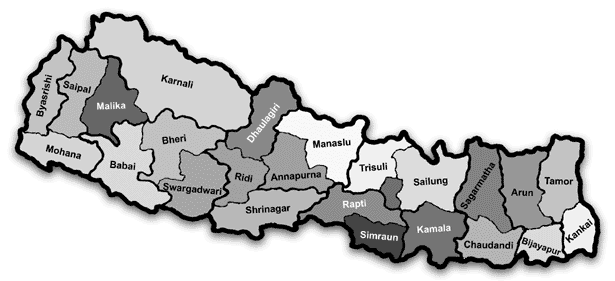
Time and again, as I travel around this land, one overwhelming complaint recurs. Kathmandu has too much power and money. Even as hill districts empty of their productive labour force, bound for the capital, people tell you that everything bad comes from Kathmandu. Bahun men listening to the radio news in the remote west, Tharu women netting fish in a flooded paddy field in the tarai, a Dalit activist in Dhading, Rai and Limbu families in the east and mountain people everywhere-all have achieved national unity on one issue. Too much Kathmandu in their lives.
For years, a powerful and compelling development mantra here has been 'decentralisation'. The empowering of the District and Village Development Committees in the 90s may have been the great success story of Nepali democracy, although it seldom gets celebrated by morose foreign aid officials these days. DDCs and VDCs, until they were crudely terminated by the Deuba government in July 2002, were the country's great hope. Some of them were doing sterling work, and hey, guess what, they were political, they were occasionally corrupt, but they worked. Local people saw democracy in action on their doorsteps.
Eventually, depending on the outcome of the current crisis and what's done to restore democracy in this country, DDCs and VDCs will spring up again. They'll be greatly hamstrung by Maoist destruction of their property and the sheer trauma of post-war life in the countryside. But I have little doubt that they'll recover and start to make a different in this country. As we saw during the peace, Kathmandu failed to deliver any development or progress to remote or distant areas outside the Valley. Why? Because the government's command structure is too centralised and unresponsive to local needs, which, in any event, are well down the priority list of problems drawn up at the Palace and in Singha Durbar.
But perhaps it's time to do more radical thinking on decentralisation. Really radical thinking. Dr Harka Gurung and others have postulated a "canton" system of government for Nepal, along the lines of Switzerland. (See Nepali Times, 'The centre cannot hold' by Harka Gurung, #88) Each of the Swiss 'cantons' are practically independent countries. They bow to the national capital on questions of defence and national finance and that's about it. The plan here to shrink the number of districts to 25 or so and give them greatly enhanced authority is a good one and needs to be dusted off and debated (see map).
What strikes me though is that political authority alone won't be enough to revitalise the districts of Nepal, even with a gusher of development money flowing through. No, whatever form of local set up is eventually agreed upon, it is going to need is a city. One each, or at least one between two or three, much as Chandigarh is shared by Punjab and Haryana states in India. The point is that Kathmandu is such a large and lone entity in Nepal that no amount of constitutional or administrative change will diminish its defacto authority. Other cities, with vibrant local and regional economies, can do that.
I humbly propose a sweeping plan to build 10 new cities all across Nepal. Each with the capacity to hold a million people. Each with parks, schools, hospitals, a university campus, regional parliaments, if you like, and so on. Housing stock is a top priority so people can live and work in comfort. And, of course, local markets and industry need electricity and other services. This would be a capital and labour intensive project on a grand scale that could pump immense new life into war-torn regions. Hundreds of thousands of laborers would be needed, skilled architects, engineers, tradespeople and so on. It would be a New Deal that will pull Nepal out of its great depression.
This country would be transformed. Kathmandu court intrigue would never again hold the hills and the tarai to ransom, and the burden on a bursting capital would be eased. Nepal would come into its own, thronging with tourists and prosperous local people who've made it in their own area, on their own, and are proud of it. I have seen the future, and it's urban.



